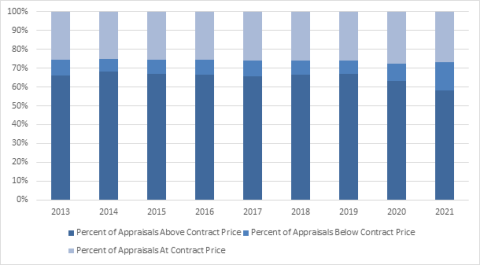Introduction
Home valuation through the appraisal process is a vital component of the home purchase, mortgage lending, and equity-building processes. The public release of appraisal data may offer a new resource to generate valuable insights. Publicly sharing appraisal data improves market transparency and supports the public in analyzing potential valuation bias and discrimination.
Accordingly, FHFA is providing new public access to millions of Uniform Appraisal Dataset (UAD) aggregate statistics derived from more than 47.3 million appraisals. The Agency has created two tools: the FHFA UAD Aggregate Statistics Data File and UAD Aggregate Statistics Dashboards. These tools will allow the public to visualize and analyze national, state, regional, and local trends in appraisal values. They also enable users to gain an understanding of how appraised values differ among neighborhoods and property characteristics, including data on the differences between appraised home values in minority neighborhoods compared to non-minority neighborhoods, over time and across both state and metropolitan areas.
FHFA Uniform Appraisal Dataset Aggregate Statistics Data File
FHFA used the UAD appraisal records to create a data file of more than 23 million UAD aggregate statistics, formally named the FHFA UAD Aggregate Statistics Data File. This dataset is derived from the UAD, which is a standardized industry dataset of appraisal information that is provided electronically to Fannie Mae and Freddie Mac (the Enterprises) through the Uniform Collateral Data Portal® (UCDP®). The Enterprises first developed the UAD in 2010 at the direction of FHFA. The UAD Aggregate Statistics Data File is intended for users that employ statistical software to extract and analyze data. The data file contains variables categorizing appraisals by year or quarter, property characteristics, and geographic location, as well as statistics such as appraisal count, mean, median, and share of appraisals below contract. Therefore, users can create their own customized analyses given specific criteria for group clustering and chart and table design, for instance.
UAD Aggregate Statistics Dashboards
The UAD Aggregate Statistics Dashboards provide easy access to millions of UAD aggregate statistics through charts and maps that are derived from the underlying FHFA UAD Aggregate Statistics Data File. The State and County dashboards will help users who want to understand trends in appraised values over time and geography. The streamlined Fair Lending dashboard is specifically built for users who are interested in fair lending outcomes by racial/ethnic neighborhood composition.
The Advanced Analytics Dashboard provides users with the option to generate customized statistics on 28 different property characteristics at various levels of geography. Figures 1 and 2 provide examples of data visualizations users may generate with this dashboard. The figures below highlight insights users may glean from the UAD Aggregate Statistics within the dashboard. Users can access the UAD Aggregate Statistics Dashboards through this link.
Figure 1: National Trends in Appraisal Valuation for Single-Family Homes

Figure 1 depicts trends in median appraisal valuation for single-family homes for both refinance and purchase loan appraisals. Between 2013Q1 and 2022Q1, the median appraisal value rose from $280,000 to $395,000.
Figure 2: Percentage of Appraisals At, Below or Above Contract Price for Single-Family Homes in the United States, 2013-2021

Figure 2 depicts the percentage of appraisals at, below or above contract prices for purchase loan appraisals. The percentage of appraisals below contract price rose from 8.4% in 2013 to 15.2% in 2021.
Summary
FHFA remains focused on accurate home valuation and assessing potential areas of bias by ensuring compliance with federal fair lending laws, evaluating appraisal standards, and working with interagency partners to share appraisal information and resources. The FHFA Uniform Appraisal Dataset Aggregate Statistics will allow users to look at trends in appraisal values over time at different geographic levels and to explore different factors contributing to variations in appraisal values. FHFA is a trusted and leading source of housing finance data, and the release of UAD Aggregate Data statistical tools is an important step in providing transparency to the public.
If you have any questions or comments about the FHFA UAD Aggregate Statistics Data File or Dashboards, please email Statistical_Products@fhfa.gov.
Tagged: FHFA Stats Blog; Aggregate Statistics; Appraisals; Data; Data Dashboards; Open Data; Source: FHFA; Uniform Residential Appraisal Report (URAR)
By: FHFA Division of Research and Statistics, Statistical Products Branch